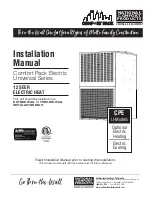
Rev. F, December 2020
Page 14
Pro-Wedge VM-20 Operator’s Manual
from the point where the nip rollers pinch down on the material. Slide the wedge to
its engaged position until it locks into its detent. Then lock the nip pressure lever
down on to the material.
Note 1
: Make sure if using a split wedge with an air channel pin,
that the notch is cut in
the end of the doubled-up piece of material
as it is detailed on the material template.
This is to allow clearance for the air channel finger when the material set-up piece is in
place.
With a Phillips screw driver remove lower frame chain cover to expose the
lockdown bolt for the front lower contour roller (#4, Figure 7.6).
Using a 6mm Allen wrench, loosen the lockdown bolt and then temporarily adjust
the front lower contour roller down, clockwise, away from the wedge using a
4mm Allen wrench on the end of the roller (this will give you a fresh starting
point and you will make a final adjustment on this roller later).
Using a 13mm open end wrench, loosen the lockdown bolt (hex head) for the rear
lower contour roller (#3, Figure 6). You can now adjust the height of the wedge
by adjusting the rear lower contour roller up or down with a 4mm Allen wrench at
the end of the roller. Once the desired position has been achieved, tighten the
lockdown bolt (hex head) then check the adjustment again to make sure it did not
move when tightened.
Note 2
: The most important adjustment is the positioning of the wedge in relationship to
the lower nip roller (#2, Figure 6). The distance between the lower tip of the heating
wedge and the lower nip roller should be slightly more than the thickness of the material
you will be welding. The distance is set by adjusting the rear lower contour roller (#3,
Figure 6) up or down.
Note 3
: When adjusting the lower contour rollers (#4) and (#3) rotate them both to the right
(counterclockwise) and up so that in their adjusted positions the rollers are closest to the
nip roller (#2). Also because the rear contour roller (#3) is forcing the wedge up against
the upper contour roller spring tension, you may notice the roller will still spin with your
fingers. This is normal. The amount of resistance of the roller when turning it with your
fingers does not matter.
Note 4
: The lower contour rollers are mounted to the lower frame on eccentric cams that
thread onto the lockdown bolts. When adjusting, you may need to work the 4mm Allen
wrench and the 6mm Allen wrench for the front contour roller (4)) or the 13mm open end
wrench for the rear contour roller (3)) simultaneously to rotate the roller smoothly.














































